check engine HONDA ACCORD COUPE 2001 CF / 6.G Owners Manual
[x] Cancel search | Manufacturer: HONDA, Model Year: 2001, Model line: ACCORD COUPE, Model: HONDA ACCORD COUPE 2001 CF / 6.GPages: 372, PDF Size: 6.1 MB
Page 19 of 372
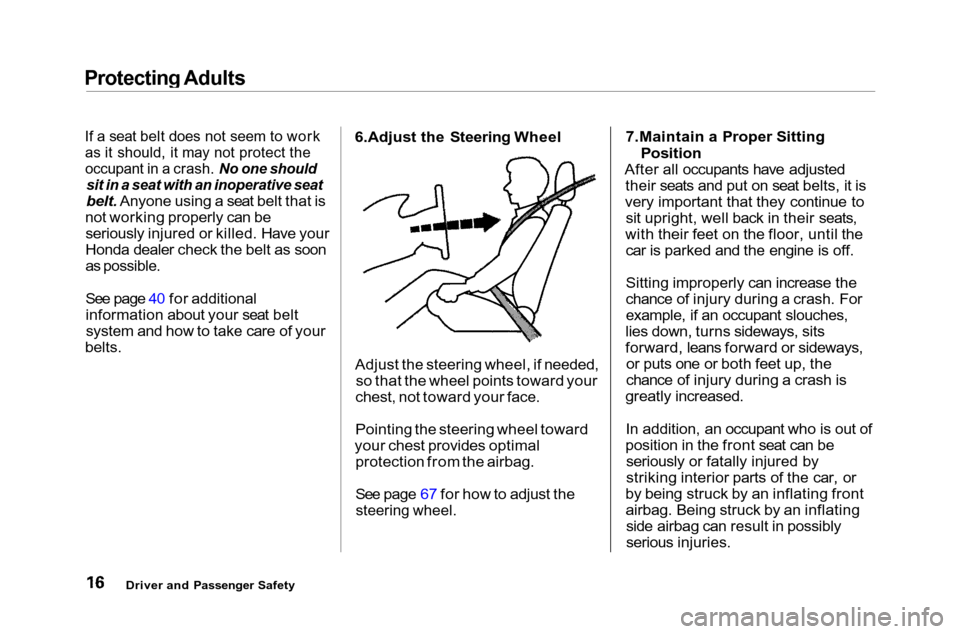
Protecting Adults
If a seat belt does not seem to work
as it should, it may not protect the
occupant in a crash. No one should
sit in a seat with an inoperative seat
belt. Anyone using a seat belt that is
not working properly can be seriously injured or killed. Have your
Honda dealer check the belt as soon
as possible.
See page 40 for additional
information about your seat beltsystem and how to take care of your
belts.
6.Adjust the Steering Wheel
Adjust the steering wheel, if needed, so that the wheel points toward your
chest, not toward your face.
Pointing the steering wheel toward
your chest provides optimal protection from the airbag.
See page 67 for how to adjust the
steering wheel.
7.Maintain a Proper Sitting
Position
After all occupants have adjusted their seats and put on seat belts, it is
very important that they continue to sit upright, well back in their seats,
with their feet on the floor, until the car is parked and the engine is off.
Sitting improperly can increase the
chance of injury during a crash. For
example, if an occupant slouches,
lies down, turns sideways, sits
forward, leans forward or sideways, or puts one or both feet up, the
chance of injury during a crash is
greatly increased.
In addition, an occupant who is out of
position in the front seat can be seriously or fatally injured by
striking interior parts of the car, or
by being struck by an inflating front airbag. Being struck by an inflatingside airbag can result in possibly
serious injuries.
Driver and Passenger Safety
Page 49 of 372
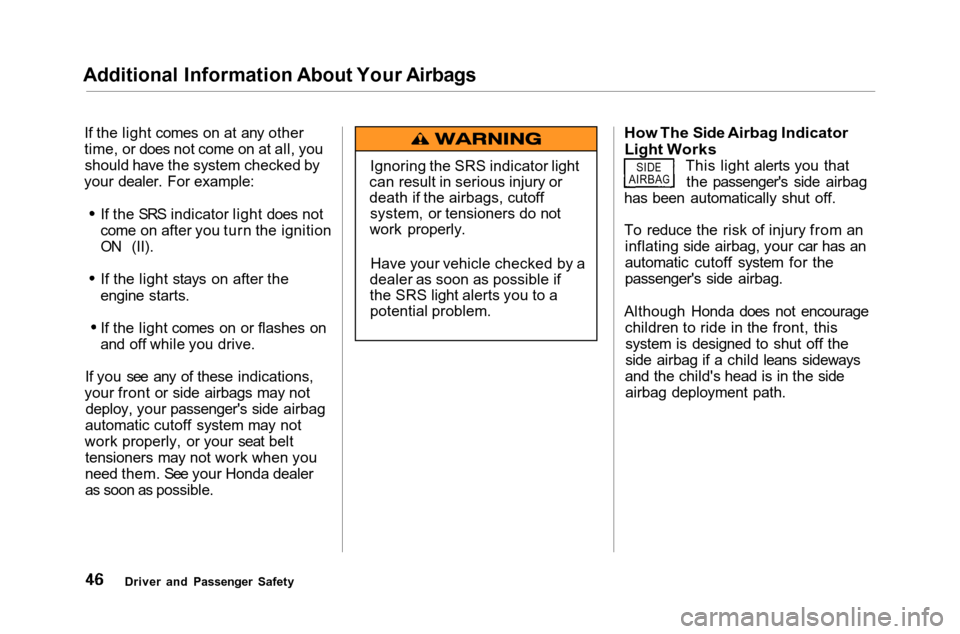
Additional Information About Your Airbags
If the light comes on at any other
time, or does not come on at all, youshould have the system checked by
your dealer. For example:
If the SRS indicator light does not
come on after you turn the ignition
ON (II).
If the light stays on after the
engine starts.
If the light comes on or flashes on
and off while you drive.
If you see any of these indications,
your front or side airbags may not deploy, your passenger's side airbag
automatic cutoff system may not
work properly, or your seat belt tensioners may not work when you
need them. See your Honda dealer
as soon as possible.
How The Side Airbag Indicator
Light Works
This light alerts you thatthe passenger's side airbag
has been automatically shut off.
To reduce the risk of injury from an inflating side airbag, your car has an
automatic cutoff system for the
passenger's side airbag.
Although Honda does not encourage children to ride in the front, thissystem is designed to shut off the
side airbag if a child leans sideways
and the child's head is in the side airbag deployment path.
Driver and Passenger Safety
SIDEAIRBAG
Ignoring the SRS indicator light
can result in serious injury or
death if the airbags, cutoff system, or tensioners do not
work properly.
Have your vehicle checked by a
dealer as soon as possible if
the SRS light alerts you to a potential problem.
Page 58 of 372
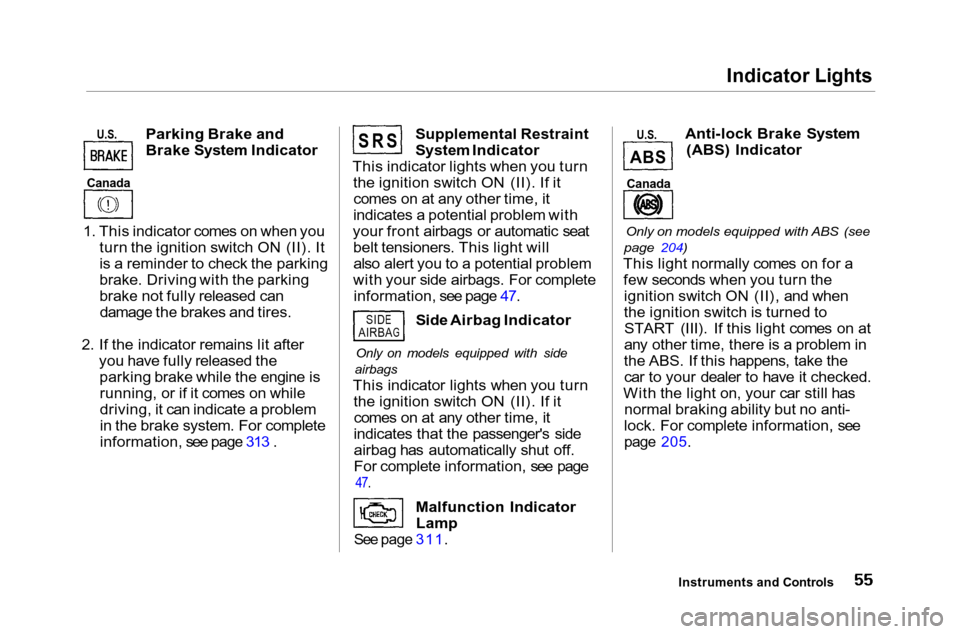
Indicator Lights
U.S.
Parking Brake and
Brake System Indicator
1. This indicator comes on when you turn the ignition switch ON (II). It
is a reminder to check the parking
brake. Driving with the parking
brake not fully released candamage the brakes and tires.
2. If the indicator remains lit after you have fully released theparking brake while the engine isrunning, or if it comes on while
driving, it can indicate a problem
in the brake system. For complete
information, see page 313 .
Supplemental Restraint
System Indicator
This indicator lights when you turn the ignition switch ON (II). If itcomes on at any other time, it
indicates a potential problem with
your front airbags or automatic seat belt tensioners. This light willalso alert you to a potential problem
with your side airbags. For complete information, see page 47.
Side Airbag Indicator
Only on models equipped with side
airbags
This indicator lights when you turn the ignition switch ON (II). If itcomes on at any other time, it
indicates that the passenger's side airbag has automatically shut off.
For complete information, see page
47.
Malfunction IndicatorLamp
See page 311.
U.S.
Anti-lock Brake System
(ABS) Indicator
Only on models equipped with ABS (see
page 204)
This light normally comes on for a few seconds when you turn theignition switch ON (II), and when
the ignition switch is turned toSTART (III). If this light comes on at
any other time, there is a problem in
the ABS. If this happens, take the car to your dealer to have it checked.
With the light on, your car still has normal braking ability but no anti-
lock. For complete information, see
page 205.
Instruments and Controls
Canada
S R S
SIDEAIRBAG
A B S
Canada
Page 62 of 372
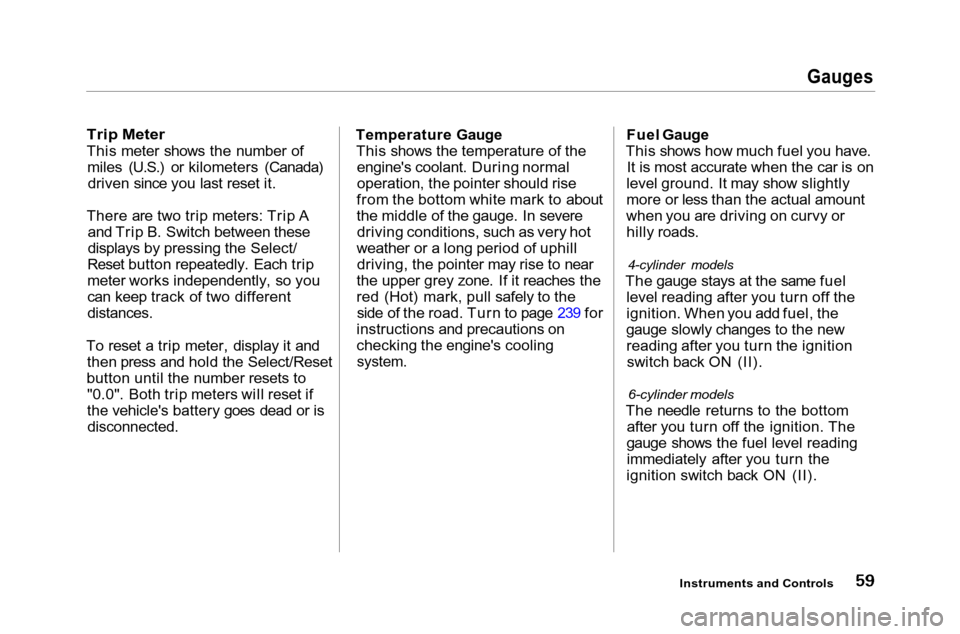
Gauges
Trip Meter
This meter shows the number of miles (U.S.) or kilometers (Canada)driven since you last reset it.
There are two trip meters: Trip A and Trip B. Switch between these
displays by pressing the Select/
Reset button repeatedly. Each trip
meter works independently, so you
can keep track of two different
distances.
To reset a trip meter, display it and then press and hold the Select/Reset
button until the number resets to "0.0". Both trip meters will reset if
the vehicle's battery goes dead or isdisconnected. Temperature Gauge
This shows the temperature of the engine's coolant. During normal
operation, the pointer should rise
from the bottom white mark to about
the middle of the gauge. In severe driving conditions, such as very hot
weather or a long period of uphill driving, the pointer may rise to near
the upper grey zone. If it reaches the
red (Hot) mark, pull safely to the side of the road. Turn to page 239 for
instructions and precautions on
checking the engine's cooling
system.
Fuel Gauge
This shows how much fuel you have. It is most accurate when the car is on
level ground. It may show slightly
more or less than the actual amount
when you are driving on curvy or hilly roads.
4-cylinder models
The gauge stays at the same fuel level reading after you turn off the
ignition. When you add fuel, the
gauge slowly changes to the new reading after you turn the ignitionswitch back ON (II).
6-cylinder models
The needle returns to the bottom after you turn off the ignition. The
gauge shows the fuel level reading immediately after you turn the
ignition switch back ON (II).
Instruments and Controls
Page 180 of 372

Before Driving
Before you begin driving your Honda,
you should know what gasoline to use, and how to check the levels of
important fluids. You also need to
know how to properly store luggage or packages. The information in this
section will help you. If you plan to
add any accessories to your car,
please read the information in this section first. Break-in Period.............................. 178
Gasoline.......................................... 178
Service Station Procedures .......... 178 Filling the Fuel Tank................. 178Opening the Hood..................... 180 Oil Check................................ 182
Engine Coolant Check.......... 184
Fuel Economy................................ 185 Vehicle Condition...................... 185Driving Habits............................ 185
Accessories and Modifications.... 186 Carrying Cargo.............................. 188
Before Driving
Page 185 of 372
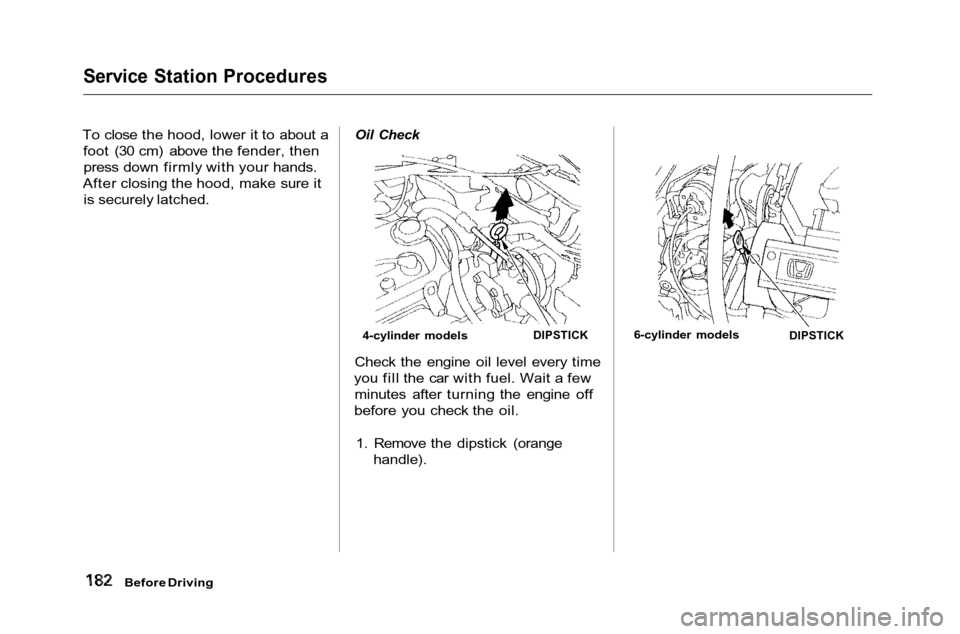
Service Station Procedures
To close the hood, lower it to about a foot (30 cm) above the fender, thenpress down firmly with your hands.
After closing the hood, make sure it is securely latched.
Oil Check
Check the engine oil level every time
you fill the car with fuel. Wait a few minutes after turning the engine off
before you check the oil.
1. Remove the dipstick (orange handle).
Before Driving
4-cylinder models
DIPSTICK
6-cylinder models
DIPSTICK
Page 187 of 372
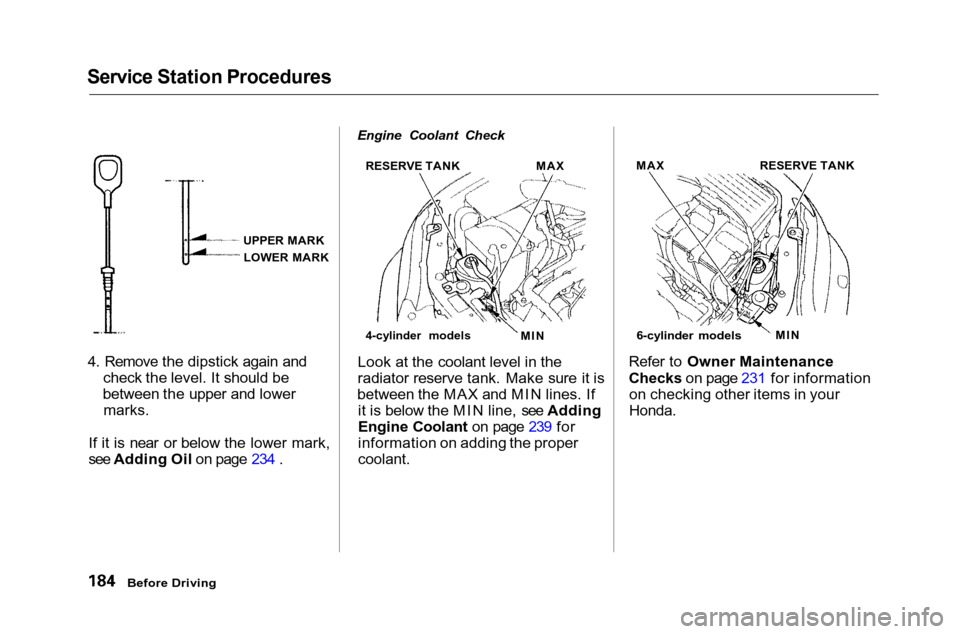
Service Station Procedures
4. Remove the dipstick again and check the level. It should be
between the upper and lower marks.
If it is near or below the lower mark,
see Adding Oil on page 234 . Engine Coolant Check
Look at the coolant level in the
radiator reserve tank. Make sure it is
between the MAX and MIN lines. If it is below the MIN line, see Adding
Engine Coolant on page 239 for
information on adding the proper
coolant.
Refer to Owner Maintenance
Checks on page 231 for information
on checking other items in your
Honda.
Before Driving
UPPER MARK
LOWER MARK
MAX
RESERVE TANK
MIN
4-cylinder models RESERVE TANK
6-cylinder models
MIN
MAX
Page 188 of 372

Fuel Economy
The condition of your car and your driving habits are the two most
important things that affect the fuel
mileage you get.
Vehicle Condition Always maintain your car according to the maintenance schedule. This
will keep it in top operating condition.
An important part of that mainte- nance is the Owner Maintenance
Checks (see page 231). For
example, an underinflated tire
causes more "rolling resistance,"
which uses fuel. It also wears out faster, so check the tire pressure at
least monthly.
In winter, the build-up of snow on
your car's underside adds weight and rolling resistance. Frequent cleaning
helps your fuel mileage and reduces
the chance of corrosion. Driving Habits
You can improve fuel economy by driving moderately. Rapid acceler-
ation, abrupt cornering, and hard
braking use more fuel.
Always drive in the highest gear that allows the engine to run and acceler-ate smoothly.
Depending on traffic conditions, try
to maintain a constant speed. Every
time you slow down and speed up,
your car uses extra fuel. Use the cruise control, when appropriate, to
increase fuel economy. A cold engine uses more fuel than a
warm engine. It is not necessary to
"warm-up" a cold engine by letting it
idle for a long time. You can drive
away in about a minute, no matter
how cold it is outside. The engine
will warm up faster, and you get better fuel economy. To cut down on
the number of "cold starts," try tocombine several short trips into one.
The air conditioning puts an extra load on the engine which makes ituse more fuel. Turn off the A/C to
cut down on air conditioning use.
Use the flow-through ventilation
when the outside air temperature is moderate.
Before Driving
Page 195 of 372
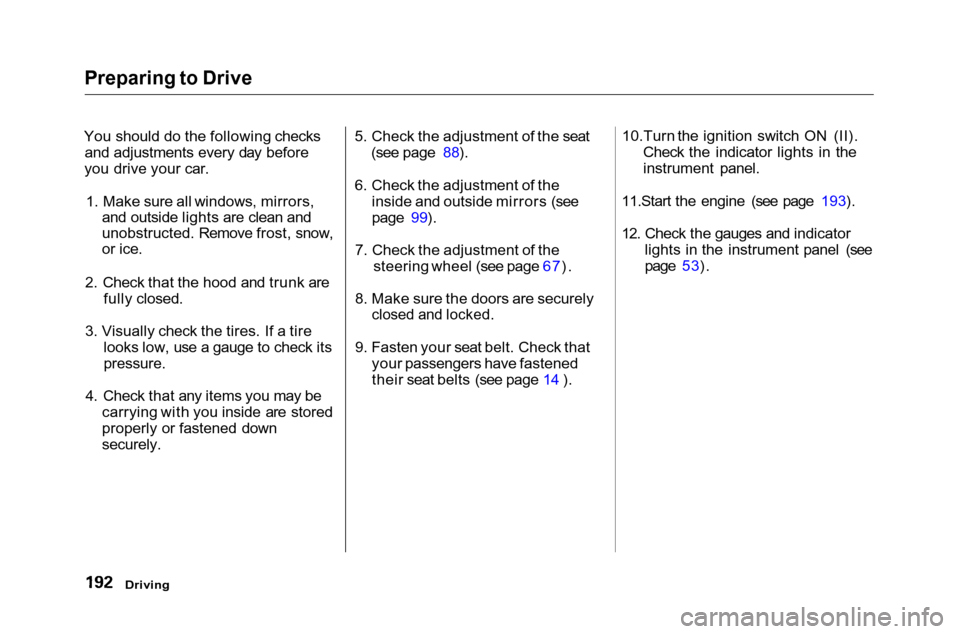
Preparing to Drive
You should do the following checks and adjustments every day before
you drive your car.
1. Make sure all windows, mirrors, and outside lights are clean and
unobstructed. Remove frost, snow,
or ice.
2. Check that the hood and trunk are fully closed.
3. Visually check the tires. If a tire looks low, use a gauge to check its
pressure.
4. Check that any items you may be carrying with you inside are stored
properly or fastened down
securely. 5. Check the adjustment of the seat
(see page 88).
6. Check the adjustment of the inside and outside mirrors (see
page 99).
7. Check the adjustment of the steering wheel (see page 67).
8. Make sure the doors are securely
closed and locked.
9. Fasten your seat belt. Check that your passengers have fastened
their seat belts (see page 14 ). 10.Turn the ignition switch ON (II).
Check the indicator lights in the
instrument panel.
11.Start the engine (see page 193).
12. Check the gauges and indicator lights in the instrument panel (see
page 53).
Driving
Page 200 of 372
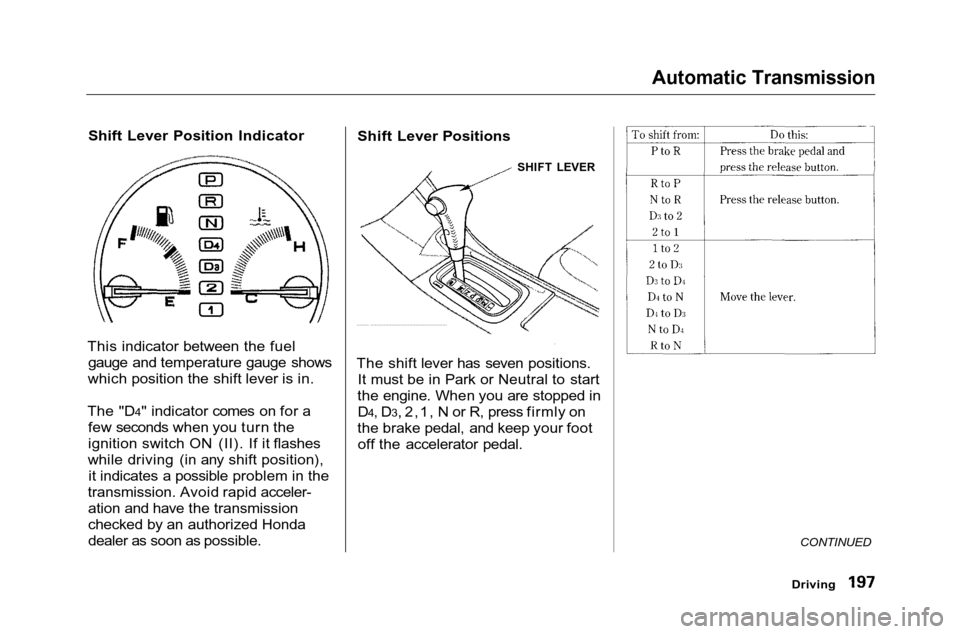
Automatic Transmission
Shift Lever Position Indicator
This indicator between the fuel gauge and temperature gauge shows
which position the shift lever is in.
The "D4" indicator comes on for a few seconds when you turn the
ignition switch ON (II). If it flashes
while driving (in any shift position), it indicates a possible problem in the
transmission. Avoid rapid acceler- ation and have the transmission
checked by an authorized Honda
dealer as soon as possible. Shift Lever Positions
SHIFT LEVER
The shift lever has seven positions. It must be in Park or Neutral to start
the engine. When you are stopped in D4, D3, 2,1, N or R, press firmly on
the brake pedal, and keep your foot off the accelerator pedal.
CONTINUED
Driving